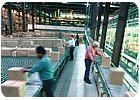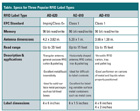There Is a "Best Choice"
Choosing
the right RFID label design for your job.

 If
you are responsible for specifying RFID labels for an in-house labeling
operation, be sure to select RFID labels that are application-compatible.
Choosing the correct label is as important as purchasing the right RFID
printer/encoder or print/apply system. The optimal RFID label design can help
ensure high label read rates, whereas a poor choice can result in a high number
of “dead” labels.
If
you are responsible for specifying RFID labels for an in-house labeling
operation, be sure to select RFID labels that are application-compatible.
Choosing the correct label is as important as purchasing the right RFID
printer/encoder or print/apply system. The optimal RFID label design can help
ensure high label read rates, whereas a poor choice can result in a high number
of “dead” labels.
Knowing the basics of RFID label construction can make label selection easier. Unlike standard labels, RFID labels consist of three integrated layers: the label surface or facestock, which carries visible printed information and bar codes; the liner, which adheres to the carton or product; and the inlay, a layer of plastic film inserted between the facestock and liner. The inlay contains a small metal antenna attached to an integrated circuit.
RFID labels are available in various sizes, and with different antenna configurations to fit different applications. The table presents specs for three popular RFID label types: AD-620, AD-610 and AD-410. Note the varying antenna dimensions and suggested label applications.
Certain applications pose special challenges for RFID labels. For example, metal containers such as aluminum cans can deflect radio frequency signals, impairing signal transmission between encoded labels and RFID readers. Containers holding liquids can also interfere with RFID signals, resulting in poor read rates. In these cases, choose RFID labels that are recommended for use with liquids or metals. Your RFID label supplier can help you make a good selection.
For more information, contact Dan L. Williams, Marketing Manager, Avery Dennison Printer Systems, phone (215) 728-8054, e-mail Dan.L.Williams@averydennison.com, or visit www.ris.averydennison.com.


Knowing the basics of RFID label construction can make label selection easier. Unlike standard labels, RFID labels consist of three integrated layers: the label surface or facestock, which carries visible printed information and bar codes; the liner, which adheres to the carton or product; and the inlay, a layer of plastic film inserted between the facestock and liner. The inlay contains a small metal antenna attached to an integrated circuit.
RFID labels are available in various sizes, and with different antenna configurations to fit different applications. The table presents specs for three popular RFID label types: AD-620, AD-610 and AD-410. Note the varying antenna dimensions and suggested label applications.
Certain applications pose special challenges for RFID labels. For example, metal containers such as aluminum cans can deflect radio frequency signals, impairing signal transmission between encoded labels and RFID readers. Containers holding liquids can also interfere with RFID signals, resulting in poor read rates. In these cases, choose RFID labels that are recommended for use with liquids or metals. Your RFID label supplier can help you make a good selection.
For more information, contact Dan L. Williams, Marketing Manager, Avery Dennison Printer Systems, phone (215) 728-8054, e-mail Dan.L.Williams@averydennison.com, or visit www.ris.averydennison.com.
Links
Looking for a reprint of this article?
From high-res PDFs to custom plaques, order your copy today!


